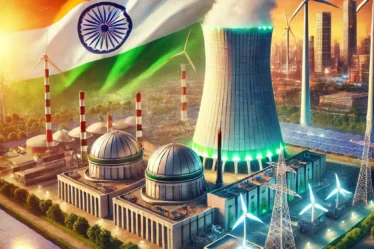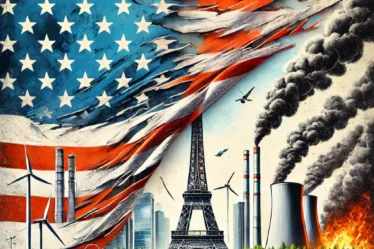Subrat Sarma is a Postgraduate Student at the Department of Politics and International Studies, Pondicherry University, India.
The 2022 UN climate change conference or COP-27 (27th Conference of Parties) will be remembered for the agreement on the Loss and Damage fund. This is a huge triumph for developing nations that are highly vulnerable to climate change after decades of struggle to establish a fund. Since COP-26, a tremendous shift is seen in the discussion and the stances of industrialized nations as there have been new building blocks in the implementation of the Paris Agreement. It is crucial that parties maintain the momentum achieved in Sharm el-Sheikh while difficult conversations over the new loss and damage fund’s operational details and financial contributors develop.
Intense differences between rich and poor countries have consistently characterized international climate change negotiations, notwithstanding the clear discrepancies in the causes and implications of climate change. Most of them have hit a brick wall when it comes to the issue of emissions reduction and altering consumption and production patterns, or when it comes to developing nations trying to end poverty by limiting emissions at the expense of development. The term “right to growth” is frequently used in discourses about climate change, but its practical influence is minimal. These arguments, which place the blame for these concepts on specific governments while downplaying the number of actors that operate both within and outside of states and share some of the blame, can be particularly problematic. Given the importance of these actors to climate change, it is essential to understand that states are not rigidly defined entities but rather organizational frameworks made up of small components like population, territory, and government. Understanding this diversity is necessary to investigate the link between climate change and international relations.
The climate change discourse between developed and developing countries often revolves around the issue of responsibility and burden-sharing. Developed countries are constantly reminded that they have a greater historical responsibility for causing climate change and should therefore take the lead in addressing the issue through emissions reduction and financial support. Developing countries, on the other hand, say that they should not be held responsible for emissions generated by developed countries in the past and that they need to prioritize their own developmental needs, including access to energy and economic growth. However, are countries genuinely on track to meet the goals outlined in the Paris Agreement?
The 46 countries that make up the LDC (Least Developed Countries) group, which represents just a small portion of the world’s emissions, engage in collective bargaining to advance the interests of developing nations at the U.N. summit. The EU has long prioritized issues like improving the capacity of vulnerable populations to adapt to climate change and determining who should pay developing countries to transition to clean energy. According to the International Renewable Energy Agency, developing countries still have significant difficulties gaining access to renewable energy financing, with Africa receiving only 2 percent of all investments in the sector over the past 20 years. Structured racism is just one of the disparities that are closely linked to climate change. People with much less privilege in society—whether because of their race, gender, or other characteristics—are likely to be severely affected by climate change, even in the same nation or city. The argument also holds true across generations: youth and future generations have made little contribution to global warming but will bear the brunt of its effects over the course of this century. Based on these facts, the idea of “climate justice” places an ethical dilemma at the center of the case for taking action on climate change.
More generally, climate justice emphasizes how wealthy populations globally contribute disproportionately to climate change due to their greater per capita emissions. It is also underlined that the extraction of fossil fuels has frequently harmed the lands and health of oppressed people while a relatively small number of corporations have benefited. “For 30 years we have been making emissions reductions targets but the fossil fuel industry has been continuously expanding production,” Tzeporah Berman, chair of the initiative fossil fuel non-proliferation treaty, said at COP-27. “We are trying to reduce the demand for fossil fuels without reducing the supply, which is like trying to cut with one half of the scissors. There is no treaty on what governments can produce and where and, without a treaty, we will be unable to bend the curve on emissions,” she said. This is due to the fact that fossil fuel companies have a significant role in driving emissions and have attempted to ignore their liability as well as the case for changing course. As the world is moving forward we have to also be cognizant of the state of our environment and planet, and climate justice will help pave the way for an equitable and sustainable world.
Why is it Necessary to Address Climate Justice?
By emitting significantly high amount of greenhouse gases, industrialized nations have grown economically. Rich countries have accumulated a “climate debt” and have a historical responsibility to repay it. It means transferring adequate public finance and technology to developing countries to tackle climate change and build low-carbon economies while addressing the urgent need for development. This “climate finance” is a matter of justice and will help ensure a safer climate, more secure livelihoods, and clean, affordable energy for everyone. Sadly, wealthy nations have yet to commit to any specific plan of action to carry on their 2009 promise to provide $100 billion in new climate finance by 2020.
Strategies and methods for addressing climate change are being developed globally. The fact is that the impacts of climate change will initially be seen at the local level rather than at the international or national level. The poor nations are the ones who have to face the problem the most. As a result, it would appear that a scalar paradox is established between the events experienced at one level and the choice made—or not made—at a different level. Yet, it is due to the universal nature of climate change – and the responsibilities for it – that the international level provides the most effective route towards mitigation and adaptation.
The Kyoto Protocol and the Paris Agreement have called for financial help from the rich countries to provide capabilities to the low and developing nations that are more vulnerable to climate change. Developing countries should only be pushed to address the climate crisis with the promise and delivery of finance, as still many lack access to energy with insufficient funds to deal with the problem of climate change. They are at a stage where there is a choice but only to adapt to the new climate normal, encompassing heat waves, cold waves, droughts, and floods. The recent instances give us a crucial interpretation of climate change, namely that it signifies an existential crisis for the globe. However, more work needs to be done to comprehend the connections between climate change and global governance because of the ecological crises in which many people would find themselves.
With unprecedented extreme weather and climate-related calamities like fires, floods, and cyclones, recent times have witnessed record-breaking phenomena, including hottest years on record. There is a general agreement that extreme weather and disruptions caused by conflicts over natural resources, drought, and flooding disproportionately affect the developing world, especially the underprivileged and most vulnerable, including women and children. However, achieving global leadership on climate change will necessitate multifaceted policy solutions. Even though wealthy nations like the United States, Canada, Japan, and much of Western Europe make up only 12 percent of the world’s population today, they are responsible for half of all greenhouse gases that have been released into the atmosphere over the past 170 years due to the burning of fossil fuels and industrial activities.
How Climate Change has Differentiated Impacts on the Developed and Developing Countries?
Climate change was responsible for 24.9 million weather-related displaced people just in 2019 and 23.7 million people were displaced in the year 2021. Such displacements threaten global security, national security, and development priorities. According to the Pentagon, climate change impacts act as “threat multipliers” and “conflict catalysts.” According to the State Department’s Global Fragility Strategy, environmental degradation is a significant cause of fragility. For instance, security experts claim that Al Qaeda has taken advantage of desertification to enhance possibilities for influence and recruitment in Northwest Africa. Currently, the most significant number of displacement in human history (80 million people), has been linked with harsh weather conditions.
According to the Food and Agriculture Organization, 76 percent of the 124 million people who experience “crisis levels” of acute food insecurity worldwide are affected by climate shocks and extremes, and more than half of those in developing nations reside in rural communities that depend on agriculture, a sector that is highly vulnerable to environmental disruptions. Because of climate change, many species are on the verge of extinction, which will affect crop growth, fisheries, and livestock. Rising temperatures also increase the cost of agricultural output just like in the US where agriculture contributes around $300 billion to the U.S. economy. Rising temperatures could make up to a billion people vulnerable to fatal diseases like dengue and chikungunya. According to the World Health Organization, a warmer environment could result in an additional 250,000 people dying from illnesses such as malaria each year between 2030 and 2050. According to Red Cross estimates, COVID-19 and climate change have combined to affect more than 50 million people worldwide.
Taking India as an Example of Climate Justice Discourse
India is still dealing with the same problems of eradicating poverty and securing developmental imperatives. India has historically given economic growth precedence over climate change legislation. It has maintained its stance as a developing nation in international climate negotiations and pushed for the concepts of equity and Common but Differentiated Responsibilities and Respective Capabilities (CBDR-RC) regarding reductions in GHG emissions. India is frequently regarded as the developing world’s leader in this arena, and this has implications beyond just its own policies.
The most common justification for addressing climate change in the policy community is based on energy poverty and the so-called co-benefits that can be realized when tying climate policy to better energy availability. India’s foreign policy has also been influenced by the climate change-related discourses. For instance, Prime Minister Narendra Modi has spoken to a global audience about the need for climate action. These declarations can be viewed as a visible indication of fresh ambition given the generally low expectations for India’s participation in climate agreements. In terms of international solar energy development collaboration, India has already taken the lead with the launch of the International Solar Alliance (ISA). At COP-26, India and the United Kingdom also unveiled the Green Grid Initiative-One Sun, One World, One Grid, a project to connect national grids for transboundary supply of solar power across regions.
India has promised to cut the emissions intensity of its Gross Domestic Product (GDP) by 45 percent by 2030 as part of its Nationally Determined Contributions (NDC). The updated NDC submitted to the UNFCCC by India in August 2022 for working towards climate justice is to generate approximately 50 percent of the total installed capacity of electric power from non-fossil fuel sources by 2030 with the aid of technology transfer and low-cost foreign financing including contributions from the Green Climate Fund (GCF). Also, it aims to increase the number of trees and forests to produce an additional 2.5 to 3 billion tonnes of CO2 equivalent of carbon sink by 2030. Investing more in development programmes in climate-vulnerable sectors, such as agriculture, water resources, the Himalayan region, coastal areas, health, and disaster management, can help society better adapt to the changing climate.
India’s economic interests are primarily focused on domestic issues, and it is still heavily dependent on fossil fuels such as coal and oil. As the economy continues to grow, the country’s energy demand is anticipated to increase significantly in the future. As India pushes for faster growth to lift hundreds of millions of people out of poverty and improve their standards of living, its emissions are anticipated to increase at the quickest rate in the world over the next two or three decades with more foreign investments coming into sectors such as manufacturing and infrastructure.
The targets set in the Paris Agreement by the countries for climate change indicate that the Earth’s temperature should not rise more than 2 degrees Celsius in the present time compared to the pre-industrial era. An estimation of around 1.01 trillion USD for climate finance by 2030 will be required by India for renewable energy, green transportation, sustainable food systems, and resilient cities. In COP-27 India sought more clarity on the definition of climate finance for developing countries to be able to access the flow of finance for climate action. As the costs of combating and adapting to climate change have increased, developing countries, including India, highlight how the developed nations need to accept a new global climate finance target, also known as the new collective quantified goal on climate finance (NCQG).
Conclusion
The conflicts and divergences between the Global North and the Global South have greatly influenced the climate change negotiations. The majority of future global carbon emissions are anticipated to come from rapidly developing economies, with developed economies being primarily responsible for the majority of the accumulated global greenhouse gas emissions in the atmosphere since the Industrial Revolution. Developed countries also have significantly higher per capita emissions than developing countries. It is also well known that industrialized, developing, and least developed nations all differ significantly in their susceptibility to the effects of climate change and their capacity, both financially and technologically, to adapt to those effects.
In conclusion, the climate justice discourse reflects the complex and challenging issues related to the distribution of responsibilities and resources in addressing the impacts of climate change. The next ten years will play a significant role in laying the foundation for our ability to tackle climate change. Hence, it is imperative that the 2030 Sustainable Development Goals (SDGs) are achieved by the international community. For a successful and equitable global response to climate change, developed and developing countries must work together because the developing countries do not constitute a homogeneous group. Major economies like India play a significant role in the global order and a spirit of cooperation and mutual understanding will lead to fair, equitable, and effective solutions. This will require a commitment to dialogue, transparency, and the recognition of the interdependence of countries and communities worldwide in addressing the impacts of climate change.
[The study was undertaken during internship at the Department of Geopolitics and International Relations (DGIR), Manipal Academy of Higher Education (MAHE), under the supervision of Dr. Amrita Jash, Assistant Professor, DGIR, MAHE.]
Disclaimer: The views expressed in the article are personal.


